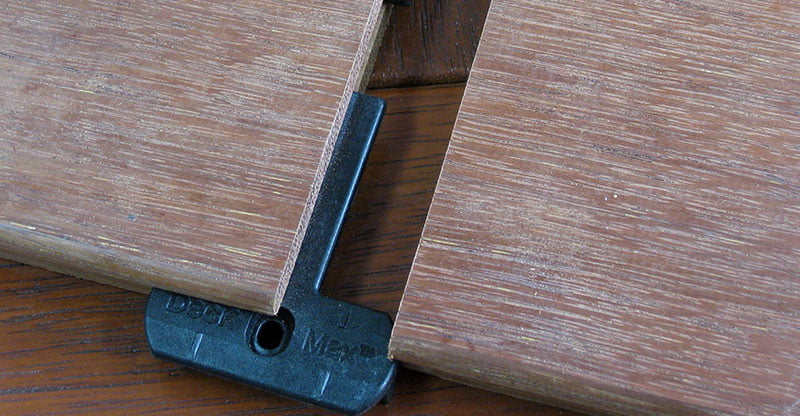In recent years, hidden deck fasteners have seen a rise in popularity.
This no nail deck fastening system gives homeowners a smooth and blemish-free deck while removing the risk of boards or nails popping due to weather changes.
Like all decking materials, hidden clips have limitations. In this article, we covered the five most important things you need to know when considering taking this option.
5 Important Things You Need To Know About Hidden Deck Clips
Hidden deck clips are great at solving issues associated with traditional methods of fastening boards to joists. Deck fasteners give deck surfaces a smooth and blemish-free look.
However, deck clips are not meant to be used on all types of deckings. An example is Pine decking.
Like all decking materials, hidden deck fasteners have some limitations. While deck clips may hold some materials down, certain projects require the stronger fastening capability of nails and screws. For example, Boardwalks and wharfs. But perfect for hardwoods, composite and bamboo.
In this article, we’ll explore the five things you need to know before you choose to use hidden fasteners for your next deck project.
1. Hidden deck clips will not give you gashes.
No nail deck fasteners are typically placed under or into the side of the decking boards by using pre-grooved, high-quality hardwoods like what Deck-Max sell. This reduces the time needed to pre-drill boards and having to align each material over a joist.
Fastening your decking using nails or screws can cause several issues, including popping nail heads that could become a tripping hazard or cause deep gashes on people walking barefoot over the deck.
With hidden deck fasteners, the risk of having boards or nails popping is greatly reduced. It also lessens the risk of splitting boards, which is very common when using screws and nails.
2. Hidden deck fasteners work best with narrower or thicker boards.
Temperature changes during winter or summer can cause the boards to expand or contract. This is where hidden deck fasteners come into their own as the clips from Deck-max allow the boards to move sideways and lengthways but retain the board flat to the surface.
Narrower deck boards are less likely to expand and contract less simply due to the lesser moisture percentage and simply less surface volume verses a wider board very important with Aussie Hardwoods.
We recommend only 90mm wide boards for Aussie hardwoods. This means the change in the gap between deck boards would be less noticeable. Additionally, narrower decking materials gain more fastening power per square meter.
Meanwhile, Deck-Max boards are more stable all round especially on the wider 135mm Merbau and Bamboo wide boards due to the extreme care and moisture control they apply to the process of manufacturing their hardwoods and bamboo decking.
3. Low clearance decks/decks closer to the ground
These decks require particularly important considerations for moisture control from rising moisture and air flow under these boards. This is where companies like Deck-max will do a discovery process with you to evaluate and determine the best design and protective measure for the longevity of the deck,
Decks close to ground will benefit from secret deck fixings as the board can expand and contract without cracking and splitting from nails or screws in the surface of the boards.
Be sure to speak to one of the experts at Deck-Max for full understanding of the location and best practice before you start building the deck – they also have Technical Data Sheets well respected as experts available for you to review in your research before making your final decision.
4. No Nail Decking Clips allow movement
Decking boards placed in the exterior area of a home are often exposed to severe weather changes, including heat, rain, and cold. These elements cause wood decking, composite decking and less so bamboo, to expand and contract, depending on the moisture content and ventilation under the deck.
Nails and screws are the last option you would select for this application as noted in other articles and above. The best way to understand why screws would be your last choice and deck clips your first is; decking boards will move by expansion and contraction, decking clips allow them to do this without damage to the boards themselves.
But, if you have nails and screws in the surface there is only one outcome. The boards MUST crack and split as they expand and contract, this also pushes the screws upwards causing a hazard.
Hidden fasteners by Deck-Max will not cause cracking and splitting as the clip in the groove simply moves with the board. This is because it is not screwed through the board but into the joist and the wing of the clip slides with the movement.
5. Hidden deck fasteners are not universal.
Some deck clip systems work better than others on specific decking materials. For example, hardwood decking products typically work best with hidden fasteners if they are pre-grooved. Softwood decking like pine decking, on the other hand, can either be screwed down.
Some systems also rely on extremely specific sizing of the board (90mm to be exact). This causes issues with fitting and retaining. As a result of this it is always best to have a consultation with experts on the topic.
Deck-Max have never had a single clip fail when installed correctly in the last 18 years of their history.
This is because we offer the highest quality pre-grooved decking with a one stop shop of clips, screws and other accessories, teamed with expertise and experience in hidden fasteners, resulting in the best outcome for all.
If you want more information about hidden decking fasteners click here. You can also call our offices 1300 306 660 to connect with a decking specialist to assist you with any enquiry.
